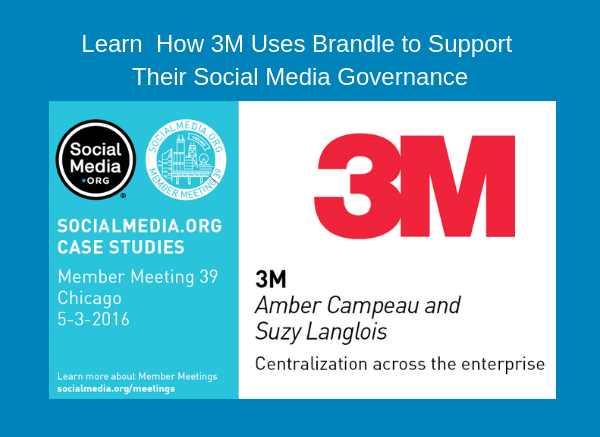 Web presence management is the process of creating and maintaining a digital inventory of all web points-of-presence (POPs) including: social media accounts and pages, websites, blogs, and domains. At first glance, web presence management may seem primarily like an administrative task. However, it is actually a strategic process critical to managing risk events as well as keeping your brand standards and voice monitored accurately. Your digital footprint is often the main entry point for your customers to experience your brand, and if your customer has a negative experience with an online point-of-presence, then your brand reputation is in jeopardy.
Web presence management is the process of creating and maintaining a digital inventory of all web points-of-presence (POPs) including: social media accounts and pages, websites, blogs, and domains. At first glance, web presence management may seem primarily like an administrative task. However, it is actually a strategic process critical to managing risk events as well as keeping your brand standards and voice monitored accurately. Your digital footprint is often the main entry point for your customers to experience your brand, and if your customer has a negative experience with an online point-of-presence, then your brand reputation is in jeopardy.
To date, most companies' web presence management has been conducted by manual audits and tracked on static spreadsheets. This not only takes a lot of human resources, but it is also fraught with human error. Stepping up to a comprehensive SaaS solution that provides an automated process does require investment, but the cost trade-off vs the risk is well worth it. So how do you get the resources and support needed from your senior management?
The first step is to become aware of the technology risks that concern your C-suite most. To that end, here are three keys to convince senior management of the importance of web presence management:
- Establish that the size of the corporation’s digital footprint is almost certainly larger than believed.
It is common that senior management significantly underestimates the size of their organization’s digital footprint. In 2012, Altimeter Group reported that enterprise class corporations (i.e. those with more than 1,000 employees) had an average of 178 social media accounts to manage (not to mention the thousand or so domains and websites). Since then, this number has grown exponentially and now includes many more global social channels and a broader domain and website strategy for IP (Intellectual Property) protection. Add the employee ambassadors that should be monitored, the partners that use the corporation's logo, and the sponsored events and properties that use a corporate brand and the POP number is in the tens of thousands. All of these POPs are legitimate and authorized accounts, blogs and websites. This is your real digital footprint.
- Establish that web presence management is connected to corporate risk management.
In 2015, AON’s Global Risk Management Survey revealed that the number one risk concern among global CEOs was — for the first time ever — risks to brands and reputations. Web presence management is not a small part of the executive strategy to manage and mitigate risk. Without appropriate web and social media presence management, the company will not and cannot know where the organization’s brand is represented on the web. Which means that the corporation has a huge blind spot on a major risk channel for the company. The growth of legitimate and authorized POPs was stated above, but comprehensive web presence management also uncovers fraudulent accounts that are either stealing your customers by selling counterfeit goods, or harming your customers by stealing their data, installing malware, and other cyber threats.
Another major risk for corporations is when the central team does not know the global owners of a channel or what tools are attached. It is critical that there is a central registry where key data (such as the account owner and their email, a secondary contact, and list of the attached tools to a POP) is kept. This ensures that a channel is always updated and also allows the IT security team to be aware of threat vectors from attached tools.
In fact, web presence management is central to a corporate risk program and should be part of the risk team's interests — gaining support from the risk team may help you gain support from your direct management.
- Establish that web presence management is required for regulatory compliance, and strengthens brand standards globally.
If your company is in a regulated industry, then you should already have support. Given the technical risks of having a digital footprint, every regulated company really must have a web presence management solution. In fact, a fine is so much greater than the cost of a SaaS solution (not to mention the time spent on an audit), that the cost comparison alone of an audit and fine vs. SaaS should be an easy presentation.
However, adhering to and strengthening brand standards is also a powerful reason to have a comprehensive solution. Your Brand is your reputation. If it is presented inconsistently across channels, or if you miss any POPs in a re-branding exercise, then your brand is weakened and so is your reputation to those who discover the inconsistency. Strong web presence management allows you to quickly view and confirm brand standards are used consistently across the globe and across channels.
Web presence management allows you to gain control over your digital footprint keeping you ahead of the risk curve so you can respond quickly to any risk event. If you need a bit more background on risks, check out 7 Social Media Security Issues your business faces as well as Understanding Key Corporate Risks. These may help you craft a presentation on how a web presence management solution mitigates risks for your company.
Learn More
To learn more about how to convince your senior management team of the importance of social media and web presence management — especially if they are not familiar with the concept and mistakenly believe that this critical function is already being performed in-house or by third party marketing agencies — then download our Enterprise Social Media Audit Case Study.
You’ll see how a global enterprise struggled with multiple social media and web audits and how they were able to achieve their goals with the Brandle Presence Manager. Armed with this information, you will be able to build a solid, fact-based business case that enables decision-makers to arrive at an informed decision that protects the organization vs. one based on partial manual audits.









